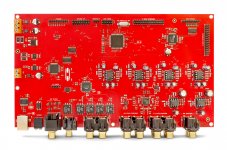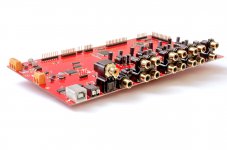Hi Macrum,
Thanks for your interest.
The price will be around USD 300 (a bit more with analogue volume, a bit less without).
Add 15% of VAT and moderate shipping costs, so around EUR 300 all together.
I like the 2x16 LCD display because it's a big standard and you can easily find any size/color to suit your project for a couple of dollars.
Upgrading the display is not going to be an easy thing, I don't want to promise anything now towards this direction.
Making the source open is also not in the pipeline. On the other hand I said earlier that if there's enough interest for it (we'll need to define at some point what 'enough' here means), I'll make a template project for who wants to program his own system - and this one could be open source.
Be aware however that this will require DSP, uC and PC coding as well as building/buying wigglers for both DSP and uC.
(Incidentally I was last week in Tyrol. Very nice!)
Regards,
Nick
Thanks for your interest.
The price will be around USD 300 (a bit more with analogue volume, a bit less without).
Add 15% of VAT and moderate shipping costs, so around EUR 300 all together.
I like the 2x16 LCD display because it's a big standard and you can easily find any size/color to suit your project for a couple of dollars.
Upgrading the display is not going to be an easy thing, I don't want to promise anything now towards this direction.
Making the source open is also not in the pipeline. On the other hand I said earlier that if there's enough interest for it (we'll need to define at some point what 'enough' here means), I'll make a template project for who wants to program his own system - and this one could be open source.
Be aware however that this will require DSP, uC and PC coding as well as building/buying wigglers for both DSP and uC.
(Incidentally I was last week in Tyrol. Very nice!)
Regards,
Nick
"Chapark" you replied earlier that the double presicion mode was most likely to
be activated in the lower regions. Is this something that will be "on" as default
or will it be "if needed" by code ?
It makes me glad that it's aimed at a higher resolution in the lower regions,
there is quite a lot of information hidden down there that will make all the
difference ones revealed.
be activated in the lower regions. Is this something that will be "on" as default
or will it be "if needed" by code ?
It makes me glad that it's aimed at a higher resolution in the lower regions,
there is quite a lot of information hidden down there that will make all the
difference ones revealed.
More interested than ever - just great stuff!
Thanks mate!
"Chapark" you replied earlier that the double presicion mode was most likely to
be activated in the lower regions. Is this something that will be "on" as default
or will it be "if needed" by code ?
It makes me glad that it's aimed at a higher resolution in the lower regions,
there is quite a lot of information hidden down there that will make all the
difference ones revealed.
I don't really 'activate' double precision, I rather code different algorithms or filter topologies depending on requirements. So this is completely transparent to the user.
It's not really that low frequencies need more resolution per se. It's the mathematics that make that in the lower frequencies, DSP coefficients for some filter topologies tend to be ill-conditioned.
The following paper is a good introduction if you're interested in this topic: AES E-Library A Survey of Biquad Filter Structures for Application to Digital Parametric Equalization
Thanks mate!
I don't really 'activate' double precision, I rather code different algorithms or filter topologies depending on requirements. So this is completely transparent to the user.
It's not really that low frequencies need more resolution per se. It's the mathematics that make that in the lower frequencies, DSP coefficients for some filter topologies tend to be ill-conditioned.
The following paper is a good introduction if you're interested in this topic: AES E-Library A Survey of Biquad Filter Structures for Application to Digital Parametric Equalization
how do you implement graphic eq's with a 1.23 fixed point dsp ?
Is the 5v analog derived from the +/-12v aimed for the dsp or the dac ?
You always have crazy questions
This 5 V is for the ADC/DACS
The DSP uses 3.3V for peripherals and 1.2V for the cores. High-performance cores always run on a low voltage otherwise it would be a heater.
Your pushbutton setup looks good!
By the way I received yesterday the production sample, finally
Pictures coming soon!
You always have crazy questions
Actually I'm working on psu's and external dac's.
Two BuffaloIIIse just assembled and I'm eagerly waiting for John Broskies
new "unballancer" for the output stages.
Just ordered a few TI ts7a4700 boards for evaluation that looks promising.
The TPS7A47 Eval Board H i F i D U I N O
http://www.ti.com/tool/tps7a4700evm-094
I also have some "Salas" and "Placid" shuntregulators.
Really looking forward to the presentation
Last edited:
I'm old enough to have my eye sight dissapering, this was a reminder of that
Actually tried a magnifying glass in front of the screenAnyway, I'm looking
forward to some more pictures
if you click on it, it should expand to a reasonable size.
- Home
- Source & Line
- Digital Line Level
- DSP Xover project (part 2)



